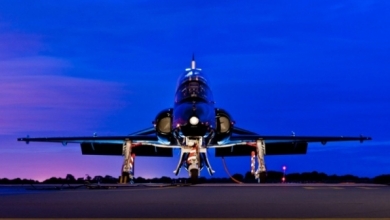
Hawk: BAE Systems
WARTON, U.K. – BAE Systems has begun systems tests on the first of 22 new Hawk jet trainers for the Royal Saudi Air Force (RSAF).
Engineers began testing the electrical, fuel and hydraulic systems of the aircraft – designated ST001 – in November. The aircraft is significant, as it is the first to be assembled by the company since 2010, and also the first to be produced in the newly reconstituted Hawk assembly line now located at Warton after it was moved from Brough, East Yorkshire, which resulted in the loss of 900 jobs at that facility.
Company officials say there have been significant challenges in restarting the production line and also re-establishing a supply chain that had virtually dried up without orders for the Hawk following the completion of the U.K. Royal Air Force’s 28 Hawk T2s.
Some 60% of the Hawk is now manufactured at Warton, with the remaining 40% at Brough. Warton had previously been responsible only for flight testing the aircraft.
The order from Saudi in 2012, along with an order from Oman in late 2013, gave new impetus to Hawk production. The company is now targeting several Middle Eastern states for potential additional orders which could help to push the number of Hawks built from 998 to more than 1,000.
Phil Hodge, business development director for the Hawk at BAE Systems, said Qatar may be looking for a new jet trainer to replace its aging Alpha Jets. Kuwait – already a Hawk user – may also consider a new-generation trainer as it looks to replace its fleet of F/A-18 Hornets in the coming years. Qatar is also expected to announce the purchase of a new fighter to replace its small fleet of Mirage 2000s. It has already established a new flight training school flying the Pilatus PC-21. Hodge also said the company was submitting a new proposal to the Indian government for an additional batch of Hawks, which could go on to equip the Indian air force’s Surya Kiran aerobatic display team.
The new batch of RSAF Hawks – designated Mk.165s – are broadly similar to their British counterparts but differ with a new data link, a different radio system and an updated version of the Rolls-Royce Adour Mk.951 engine. The Saudi aircraft will also be capable of dropping and firing ordnance, unlike the British aircraft that simulate the process. ST001 is one of 15 of the Saudi aircraft currently on the production line. It will be mated with its wing section early next year and is expected to make a first flight around May 2015.
Fourteen of the 22 aircraft will be delivered to Saudi Arabia by December 2016.
In the meantime, the company continuing deliveries of Typhoons to the RSAF and is in the process of completing the last-ever Tranche 2 standard aircraft CS030.
The remaining 42 aircraft for the RSAF will be Tranche 3 aircraft. The company has also completed delivery of all the British and Saudi two-seat aircraft, with only a trio for the Royal Air Force of Oman to be delivered, unless more orders emerge.
http://aviationweek.com/awin-only/bae-systems-powers-first-new-build-saudi-hawk
http://aviationweek.com/awin-only/bae-systems-powers-first-new-build-saudi-hawk


